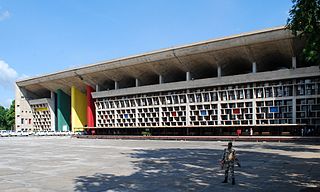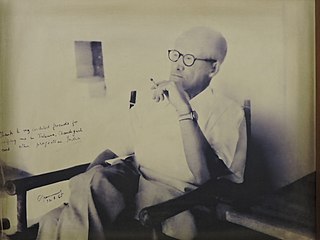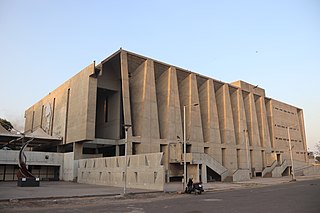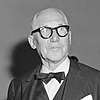Related Research Articles

Charles-Édouard Jeanneret, known as Le Corbusier, was a Swiss-French architect, designer, painter, urban planner, writer, and one of the pioneers of what is now regarded as modern architecture. He was born in Switzerland and became a French citizen in 1930. His career spanned five decades, and he designed buildings in Europe, Japan, India, and North and South America.

Chandigarh is a city, district and union territory in India that serves as the joint capital of the two neighbouring states of Punjab and Haryana. Chandigarh is bordered by the state of Punjab to the north, the west and the south, and by the state of Haryana to the east. It is considered to be a part of the Chandigarh Capital Region or Greater Chandigarh, which includes Chandigarh, and the city of Panchkula and cities of Kharar, New Chandigarh, Mohali and Zirakpur. It is located 260 km north of New Delhi and 229 km southeast of Amritsar.

Panjab University (PU) is a collegiate public university located in Chandigarh. Funded through both State and Union governments, it is considered a central, as well as a state university. It originated as an integral part of the University of the Punjab in Lahore, which was founded in 1882. After the partition of India, the University of the Punjab was divided into two distinct institutions, one in each of the two separate nations, with the Indian university initially called East Punjab University (EPU), situated at Shimla. Renamed Panjab University, it relocated to Chandigarh on October 1, 1947.

Punjab and Haryana High Court is the common High Court for the Indian states of Punjab and Haryana and the Union Territory of Chandigarh based in Chandigarh, India. Sanctioned strength of Judges of this High Court is 85 consisting of 64 Permanent Judges and 21 Additional Judges including Chief Justice. As of 1st November, 2021, there are 50 Judges in the High Court, comprising 44 Permanent and 6 Additional Judges. Past judges include Madan Mohan Punchhi, P. Sathasivam, Tirath Singh Thakur, Jagdish Singh Khehar and Ranjan Gogoi who were elevated to the Supreme Court of India and became Chief Justice of India.

Pierre Jeanneret was a Swiss architect who collaborated with his cousin, Charles-Édouard Jeanneret, for about twenty years.

Sanskar Kendra is a museum at Ahmedabad, India, designed by the architect Le Corbusier. It is a city museum depicting history, art, culture and architecture of Ahmedabad. Another Patang Kite Museum is there which includes a collection of kites, photographs, and other artifacts. The campus is located at the west end of Sardar Bridge near Paldi.

Mill Owners’ Association Building, also known as Ahmedabad Textile Mill Owners' Association House , is a modern architecture building in Ahmedabad, India designed by Swiss-French architect Le Corbusier.

Government Museum and Art Gallery, Chandigarh, is a premier museum of North India having collections of Gandharan sculptures, sculptures from ancient and medieval India, Pahari and Rajasthani miniature paintings. It owes its existence to the partition of India in August, 1947. Prior to the partition, much of the collections of art objects, paintings and sculptures present here were housed in the Central Museum, Lahore, the then capital of Punjab. The museum has one of the largest collection of Gandharan artefacts in the world.

Ville radieuse was an unrealised urban design project designed by the French-Swiss architect Le Corbusier in 1930. It constitutes one of the most influential and controversial urban design doctrines of European modernism.

The Pavillon Le Corbusier is a Swiss art museum in Zürich-Seefeld at Zürichhorn dedicated to the work of the Swiss architect Le Corbusier. In 1960 Heidi Weber had the vision to establish a museum designed by Le Corbusier – this building should exhibit his works of art in an ideal environment created by the architect himself in the then Centre Le Corbusier or Heidi Weber Museum. In April 2014 the building and museum went over to the city of Zürich, and was renamed in May 2016.

The Open Hand Monument is a symbolic structure designed by the architect Le Corbusier and located in the Capitol Complex of the Indian city and union territory of Chandigarh. It is the emblem and symbol of the Government of Chandigarh and symbolizes "the hand to give and the hand to take; peace and prosperity, and the unity of mankind". The largest example of Le Corbusier's many Open Hand sculptures, it stands 26 metres (85 ft) high. The metal structure with vanes is 14 metres (46 ft) high, weighs 50 short tons (100,000 lb), and was designed to rotate in the wind.

Secretariat Building is a Le Corbusier-designed government building built in 1953, located inside the Chandigarh Capitol Complex which comprises three buildings and three monuments: the Secretariat building, Legislative Assembly building and High Court building, Open Hand Monument, Geometric Hill and Tower of Shadows.

The Palace of Assembly is a legislative assembly building in Chandigarh, India. It was designed by modernist architect Le Corbusier. It is part of the Capitol Complex, which includes the Legislative Assembly, Secretariat and High Court. The Palace of Assembly features a circular assembly chamber, a forum for conversation and transactions, and stair-free circulation.
Aditya Prakash, was an architect, painter, academic and published author. He belonged to the first generation of Indian Modernists closely associated with Chandigarh and the developmentalist practices of postcolonial India under Jawaharlal Nehru. He designed over 60 buildings all in north India. His paintings are held in private collections worldwide. His architecture and art adhered strictly to modernist principles. As an academic, he was one of the earliest Indian champions of sustainable urbanism. He published two books and several papers on this topic. His archives are held at the Canadian Centre for Architecture at Montreal, Canada.

Urmila Eulie Chowdhury was an Indian architect who worked during the mid-to-late 20th century. She worked in the fields of general architecture, landscape architecture and design, and was also a teacher and writer. She was a pioneer woman architect working in India. Some sources state that she was also the first female architect in Asia. After her education she worked in close collaboration with Le Corbusier in the planning design and construction of the city of Chandigarh.

Chandigarh Capitol Complex, located in the sector-1 of Chandigarh city in India, is a government compound designed by the architect Le Corbusier and is a UNESCO World Heritage Site. It is spread over an area of around 100 acres and is a prime manifestation of Chandigarh's architecture. It comprises three buildings: the Palace of Assembly or Legislative Assembly, Secretariat Building and the High Court plus four monuments and a lake. It was added to the UNESCO World Heritage Site List in 2016.

Diwan Manna is an Indian conceptual artist and photographer. He completed his study in graphic art and printmaking from the Government College of Art, Chandigarh in 1982. He exhibited in India, United Kingdom, Germany, France, Poland, and Italy. From 2014-15 he served as the director of Triennale India, organised by Lalit Kala Akademi, National Academy of Art, Ministry of Culture, Govt of India. He served as the chairman of Chandigarh Lalit Kala Akademi, State Academy of Art, Department of Culture, Chandigarh Administration. Currently, he is serving as the president of Punjab Lalit Kala Akademi, State Academy of Art, Ministry of Culture, Government of Punjab, India.

Parmeshwari Lal Varma is an Indian civil engineer and a former chief engineer of Punjab. He served as an associate of Le Corbusier, the Swiss-French architect, who designed the city of Chandigarh. There have been reports that Le Corbusier wanted Verma to assist him even past his retirement from service for which Jawaharlal Nehru, the then prime minister of India, unsuccessfully requested the Government of Punjab for the extension of Verma's service. His involvement in the making of Chandigarh has been documented in a book, Le Corbusier Rediscovered: Chandigarh and Beyond, in which he has written a special article. The Government of India awarded him Padma Bhushan, the third highest Indian civilian award, in 1971.

Tagore Memorial Hall, also known as Tagore Hall, is an auditorium in Ahmedabad, India. Its design by B. V. Doshi was completed in 1961, building commenced in 1966, and the construction was completed in 1971. It was renovated in 2013, and is an example of brutalist architecture.
References
- ↑ Fondation Le Corbusier: "Palais du Gouverneur, Chandigarh", retrieved 20 October 2013
- ↑ "AD Classics: Chandigarh Secretariat", 26 September 2011
- ↑ "Le Corbusier Centre gets richer by 14 rare photographs". Indian Express. 17 March 2010. Retrieved 7 September 2013.
